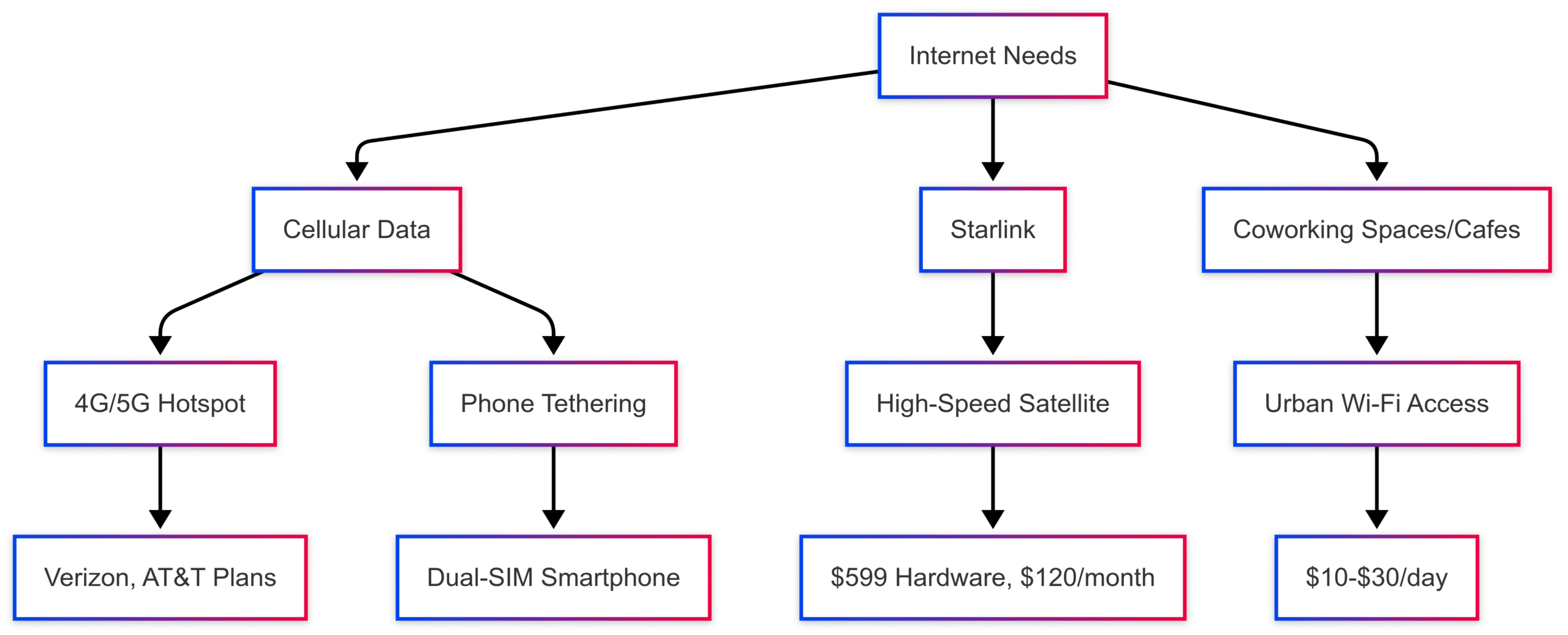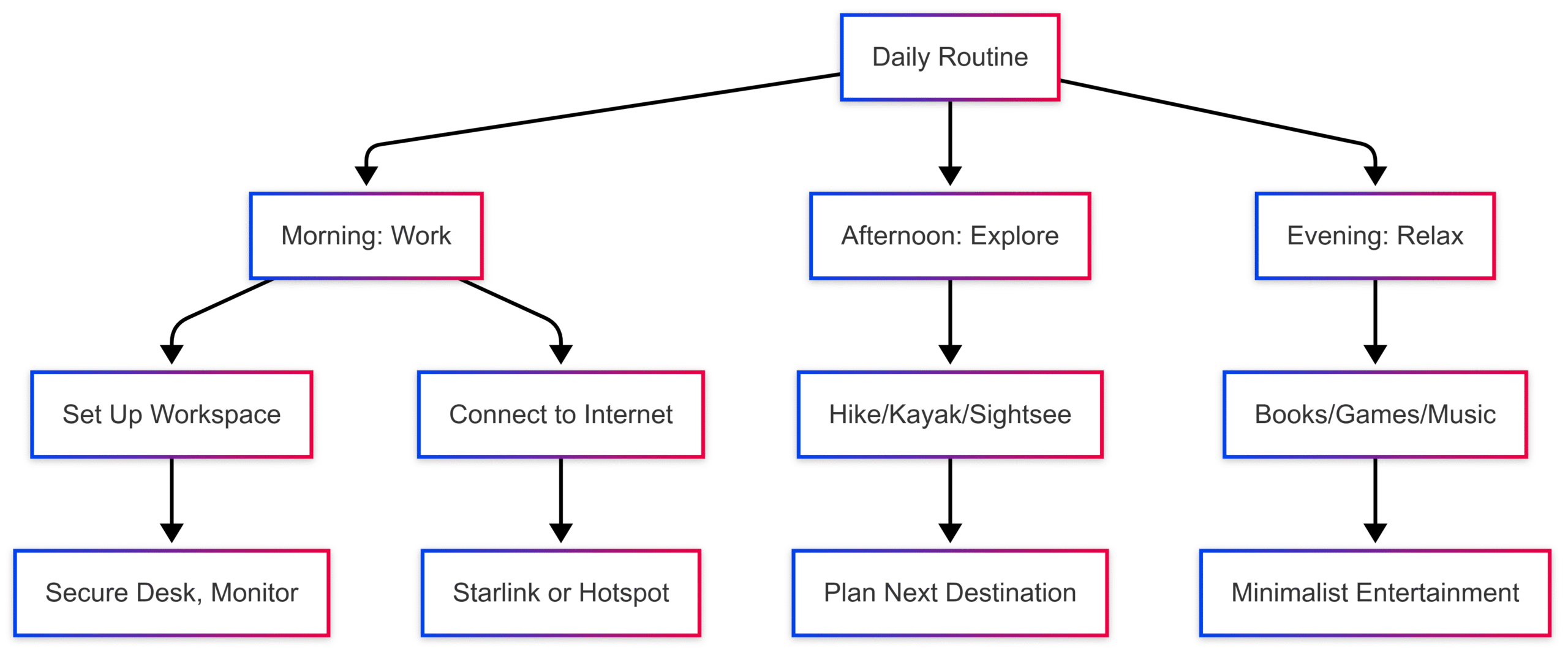Discover if van life is a viable option for digital nomads. Explore costs, setups, challenges, and tips for working remotely from a van.
The digital nomad lifestyle, characterized by remote work and global exploration, has surged in popularity as technology enables location-independent careers. Among the myriad ways to embrace this freedom, van life stands out as a compelling option. Living and working from a converted van offers a unique blend of mobility, minimalism, and adventure. But is it a practical choice for digital nomads? This article delves into the feasibility of van life, covering its benefits, challenges, costs, technical requirements, and practical tips, supported by real-world insights and data.
What is Van Life?
Van life involves converting a vehicle—typically a van, but sometimes an RV or minivan—into a mobile home equipped with essentials like a bed, kitchen, and workspace. For digital nomads, it’s a way to combine remote work with travel, leveraging the freedom to move between scenic locations while maintaining a career. The allure lies in its promise of low-cost living, flexibility, and immersion in nature, but it comes with unique demands that require careful consideration.
Why Van Life Appeals to Digital Nomads
- Freedom and Flexibility: Van life allows nomads to travel without being tethered to a fixed location. You can work from a beach in California one week and a forest in Oregon the next, chasing ideal weather or inspiration.
- Cost Savings: Compared to traditional housing or frequent Airbnb rentals, van life can reduce living expenses significantly, especially in high-cost areas.
- Minimalist Lifestyle: Living in a compact space encourages decluttering and prioritizing essentials, aligning with the minimalist ethos many nomads embrace.
- Connection with Nature: Parking in national parks or remote areas offers unparalleled access to natural beauty, enhancing work-life balance.
However, the romanticized image of van life—often fueled by Instagram-worthy conversions—can obscure practical challenges. Let’s explore the realities.
The Practicalities of Van Life for Digital Nomads
Essential Van Setup for Remote Work
To function as a digital nomad, a van must be more than a place to sleep—it needs to support a productive work environment. Key components include:
- Workspace: A sturdy desk or foldable table, secured with straps or mounts (e.g., RAM Mounts) to prevent movement during travel. Ergonomic seating is critical to avoid discomfort during long work hours.
- Power Supply: A robust electrical system is non-negotiable. Most setups include:
- Batteries: At least 675 Ah of battery capacity (e.g., lithium-ion or AGM) to power devices.
- Solar Panels: 200-400W solar arrays for off-grid charging.
- Inverter: A 1000-2000W inverter to convert DC to AC for laptops and monitors.
- Battery Charger: A three-stage charger to maintain battery health.
- Internet Connectivity: Reliable internet is the backbone of remote work. Options include:
- Cellular Data: 4G/5G hotspots or tethering via a dual-SIM smartphone. Plans like Verizon’s Unlimited or AT&T’s Prepaid offer robust coverage in the US.
- Starlink: SpaceX’s satellite internet provides high-speed connectivity (50-200 Mbps) in remote areas, with a one-time hardware cost of ~$599 and monthly fees of ~$120.
- Coworking Spaces: For urban stops, coworking spaces or cafes offer Wi-Fi and a change of scenery.
- Water and Sanitation: A minimum of 6 gallons of water per person per day for drinking, cooking, and hygiene. A 40-gallon holding tank for waste typically lasts 1-2 weeks. Portable toilets or composting units are common, though bidets increase water usage.
- Kitchen: A propane or butane stove (preferably used outside to avoid lingering odors) and a small fridge/freezer. Meal planning reduces grocery trips.
- Comfort: Insulation, fans, heaters, and comfortable bedding ensure a livable environment year-round. Portable air conditioning requires a generator, adding cost and complexity.
Sample Van Conversion Specifications
| Component | Specification | Estimated Cost (USD) |
|---|---|---|
| Van (e.g., Mercedes Sprinter) | Used, 2010-2015 model | $20,000-$40,000 |
| Solar Panels | 300W, rooftop-mounted | $500-$1,000 |
| Battery System | 675 Ah lithium-ion | $1,500-$3,000 |
| Inverter | 2000W pure sine wave | $200-$500 |
| Water Tank | 40-gallon fresh water | $100-$300 |
| Composting Toilet | Nature’s Head or similar | $900-$1,200 |
| Kitchen Setup | Propane stove, sink, fridge | $500-$1,500 |
| Workspace | Foldable desk, RAM Mounts | $200-$400 |
| Starlink Internet | Hardware + monthly plan | $599 + $120/month |
| Total (Basic Conversion) | $24,500-$47,900 |
Note: Costs vary based on van condition, DIY vs. professional conversion, and add-ons like insulation or HVAC.
Internet Connectivity Options

Benefits of Van Life for Digital Nomads
- Cost Efficiency: Van life can be remarkably affordable. For example, one nomad reported monthly expenses as low as $700 by stealth camping on free public lands (e.g., BLM land in the US or Crown land in Canada). This contrasts with Airbnb rentals, which can cost $25-$100/day in urban areas.
- Mobility: Unlike traditional nomadism, which often involves flights and short-term rentals, a van allows seamless transitions between locations without packing or booking hassles.
- Unique Experiences: Nomads like Lexi and Cody, dubbed “Van-trepreneurs,” use their van as a creative studio, filming YouTube content against stunning backdrops. Others, like yogi Brittney Rouille, find balance by escaping draining jobs for a life on the road.
- Climate Chasing: By following routes like those mapped by climatologist Brian Brettschneider, nomads can maintain 70-degree weather year-round, starting in Mexico and ending in Southern California or following a 12-month itinerary from Florida to Arizona.
Challenges of Van Life
Despite its appeal, van life presents significant hurdles, especially for digital nomads reliant on consistent work conditions.
- Internet Reliability: While Starlink has improved connectivity, cellular signals can be spotty in remote areas. Pre-Starlink solutions like mobile hotspots were less reliable, and frequent cafe visits risk drawing unwanted attention.
- Maintenance Costs: Vans require regular upkeep—oil changes, tire replacements, and unexpected repairs can cost thousands annually. One nomad noted that a breakdown can leave your “home” in the garage, disrupting work and life.
- Space Constraints: The lack of separation between living and working spaces can be mentally taxing. One commenter emphasized the exhaustion of working where you sleep, recommending coworking spaces for mental clarity.
- Legal Restrictions: Many cities, like San Diego, enforce bans on vehicle dwelling, targeting vans by height or length. Researching local laws is essential to avoid fines or towing.
- Social Isolation: Living on the road can limit social interactions. One nomad, who started van life in 2020, found it harder to meet people compared to international travel.
- Logistical Challenges: Managing water, waste, and power requires constant planning. Overflows from sanitation tanks or running out of water can disrupt daily routines.
Cost Breakdown of Van Life vs. Traditional Nomadism
| Expense Type | Van Life (Monthly, USD) | Airbnb Nomad (Monthly, USD) |
|---|---|---|
| Housing | $0-$200 (parking/campgrounds) | $750-$3,000 |
| Fuel | $100-$400 | $0 (flights separate) |
| Internet | $50-$150 | $30-$100 |
| Maintenance | $100-$500 | $0 |
| Food | $200-$400 | $200-$400 |
| Miscellaneous | $100-$200 | $100-$200 |
| Total | $550-$1,750 | $1,080-$3,700 |
Note: Van life costs assume minimal driving and stealth camping. Airbnb costs vary by location.
Tips for Successful Van Life as a Digital Nomad
Drawing from community insights and expert advice, here are practical tips to make van life viable:
- Invest in Reliable Tech:
- Use a VPN for security and access to geo-blocked content.
- Store data in the cloud to protect against theft or equipment failure.
- Carry extension cords, chargers, and a dual-SIM phone for flexibility.
- Prioritize Safety:
- Carry a first aid kit, travel insurance, and breakdown service details (e.g., AAA in the US).
- Inform someone of your location for emergencies.
- Secure pets and passengers during travel.
- Optimize Comfort:
- Invest in quality bedding, insulation, and climate control (fans, heaters).
- Use non-slip mats and straps to secure equipment.
- Plan Meals:
- Cook outside to avoid odors in the van.
- Buy local produce to save money and enhance the travel experience.
- Use portable stoves or park BBQs.
- Balance Work and Leisure:
- Schedule work in the mornings and explore in the afternoons, as one nomad does with hiking and kayaking.
- Use coworking spaces to separate work from living areas.
- Stay Flexible:
- Plan routes loosely using tools like TripAdvisor, but adapt to weather or restrictions.
- Research free parking options like BLM land to save costs.
- Maintain the Van:
- Carry tools and a repair manual for DIY fixes.
- Choose a reliable vehicle to minimize breakdowns.
- Embrace Clean Camping:
- Delegate chores to keep the van tidy.
- Recycle and respect nature to minimize environmental impact.
Van Life Workflow

Real-World Examples
- Lexi and Cody (“Van-trepreneurs”): This couple turned their Mercedes Sprinter into a mobile studio, creating YouTube content and digital products while traveling. Their setup includes a desk, solar power, and Starlink, allowing them to work against scenic backdrops.
- Brittney Rouille and Drew Neumann: Escaping unfulfilling jobs, they embraced van life for balance. They recommend taking six months on/off to save money and avoid burnout, emphasizing living in the moment.
- Yama Nomads: This Canadian company rents compact camper vans, encouraging off-grid exploration. Their smaller vehicles suit urban and rural settings, offering flexibility for nomads.
Is Van Life Right for You?
Van life is a viable option for digital nomads who value mobility, minimalism, and cost savings, but it’s not without trade-offs. It suits those comfortable with logistical challenges, occasional isolation, and hands-on maintenance. If you thrive in dynamic environments and can adapt to small spaces, van life could be transformative. However, if you need stable social connections or separate work-life spaces, traditional nomadism or coworking setups might be better.
Key Considerations
- Budget: Can you afford the upfront conversion costs ($25,000-$50,000) and ongoing maintenance?
- Lifestyle: Are you comfortable with minimalism and frequent planning for water, power, and parking?
- Work Needs: Do you have reliable internet and a suitable workspace for your job?
- Legal Awareness: Are you prepared to research local laws to avoid fines?
- Social Needs: Can you handle periods of solitude, or do you have strategies to connect with others?
Trying Van Life Before Committing
For those intrigued but unsure, renting a van is a low-risk way to test the lifestyle. Companies like Nomad Stays and Under The Stars Campers offer VW vans (e.g., Hiedi, Winni, Daisy) for short-term rentals in places like Lancashire, UK, or Australia. A one-month trial can reveal whether van life suits your work and travel style.
Sample Rental Costs
| Provider | Van Type | Rental Cost (USD, Monthly) |
|---|---|---|
| Nomad Stays | VW Camper | $2,000-$3,000 |
| Yama | Compact Camper | $1,500-$2,500 |
| Traditional RV Rental | Class B RV | $3,000-$5,000 |
Conclusion
Van life offers digital nomads a unique way to blend work and travel, with the potential for significant cost savings and unparalleled freedom. However, it demands careful planning, reliable tech, and adaptability to challenges like maintenance, connectivity, and legal restrictions. By investing in a solid van setup, prioritizing safety and comfort, and staying flexible, nomads can thrive on the road. Whether you’re inspired by “Van-trepreneurs” or seeking 70-degree weather year-round, van life is a viable—albeit demanding—option for those ready to embrace the journey.
Please share this Van Life: A Viable Option for Digital Nomads? with your friends and do a comment below about your feedback.
We will meet you on next article.
Until you can read, Workcations: The travel trend mixing work and play
